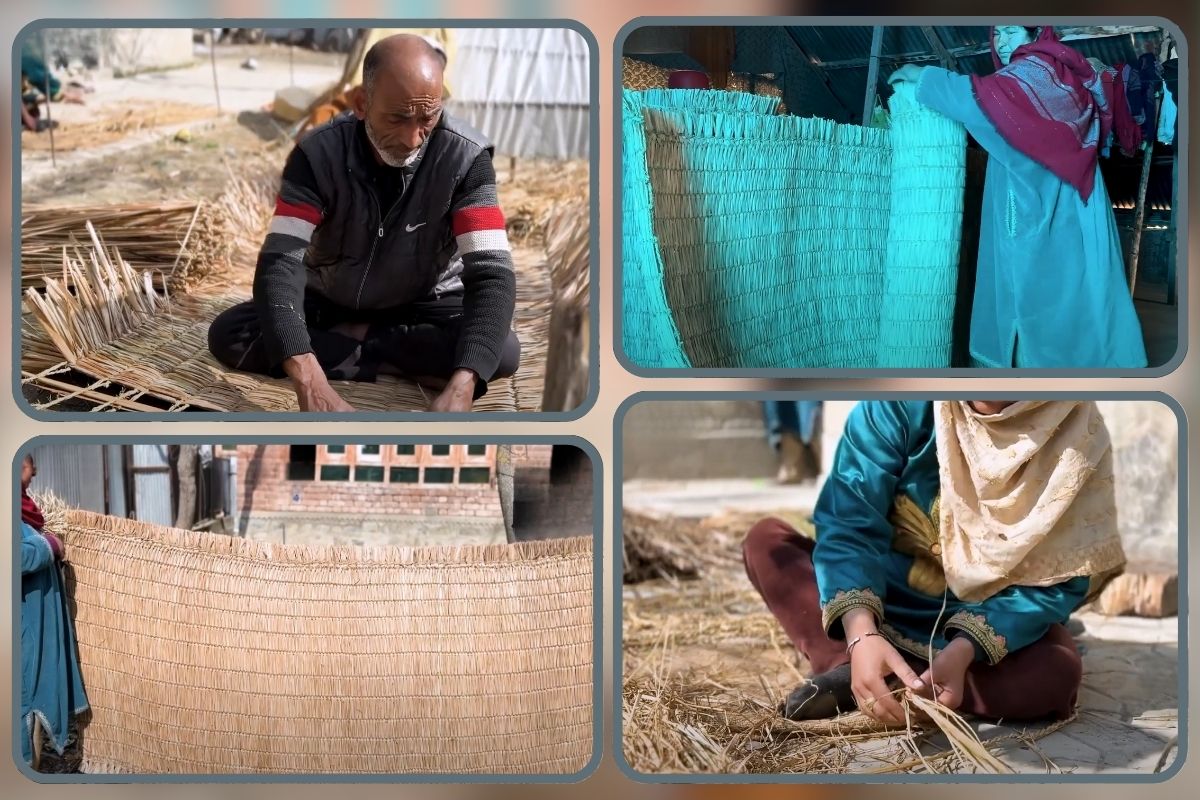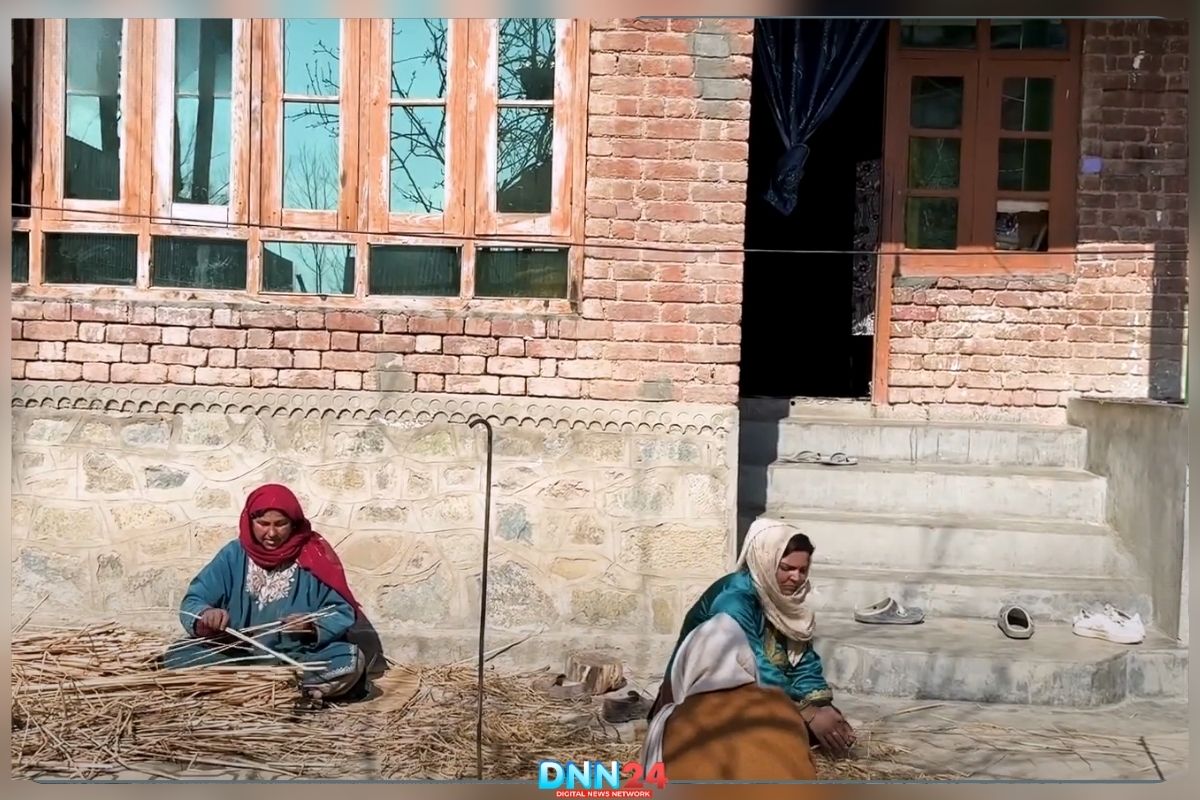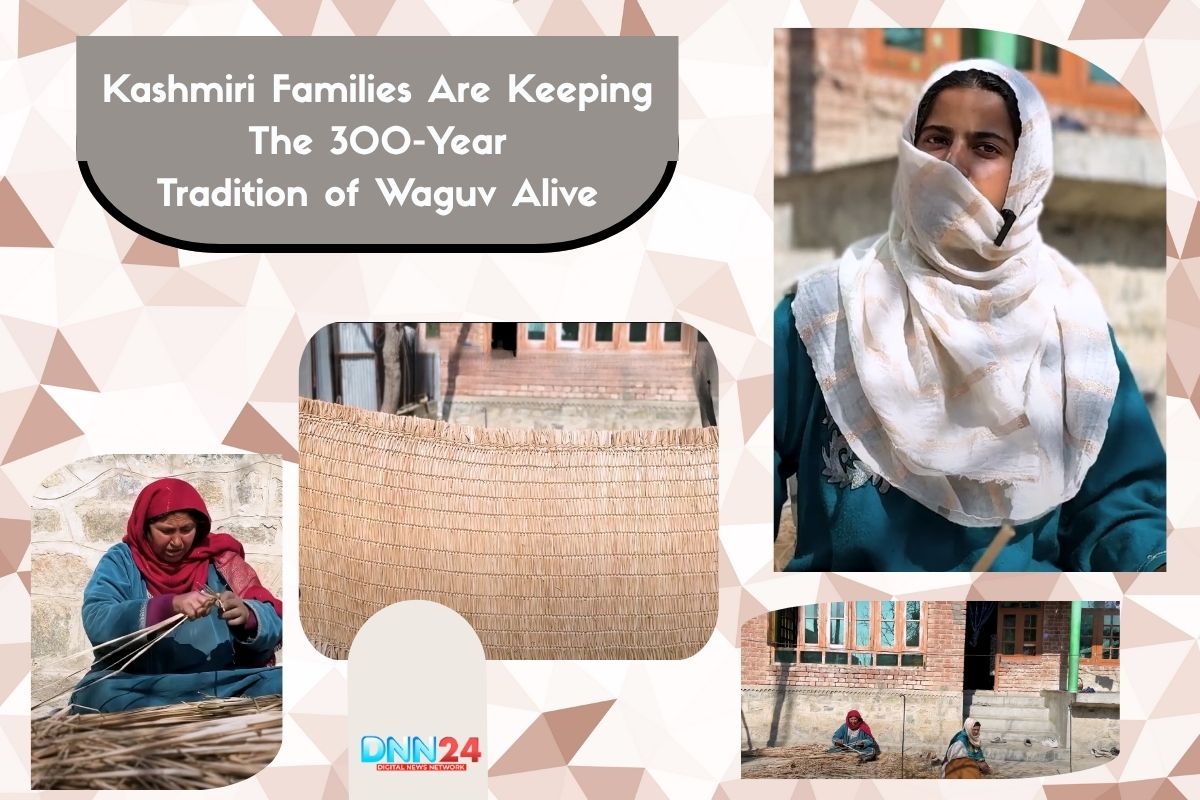In the beautiful valleys of Kashmir, beyond the famous silk and pashmina, lies a hidden treasure that has been part of Kashmiri homes for centuries – the Waguv mat. This precious handicraft, known locally as “Wago,” represents more than just a floor covering; it embodies the soul of Kashmir’s cultural heritage.
For over three centuries, this eco-friendly tradition has quietly thrived in Kashmiri households. Made from natural reeds (Typha angustifolia) and rice straw that grow along the banks of the Jhelum River and Dal Lake, these mats possess remarkable qualities—they stay warm in winter and cool in summer, making them incredibly special for daily use.
Today, around 300 families in Khojbagh village, Maloora (Srinagar), continue this ancient art with the same passion their ancestors had. While modern carpets and synthetic flooring have taken over most homes, these dedicated artisans refuse to let their heritage fade away. The tradition represents a perfect blend of sustainability, craftsmanship, and community spirit that the modern world desperately needs.
The Rich History and Cultural Significance of Waguv
The story of Waguv weaving begins three hundred years ago, when Kashmir’s ancestors needed practical solutions for their homes. At that time, carpets and modern flooring didn’t exist, so people innovated with what nature provided them—the long grass and reeds from their wetlands.

“Our grandfathers and grandmothers were doing this work from the very beginning, and today’s new generation is also continuing the same work,” explains a local artisan. This continuity represents something more profound than just craft-making; it shows how families have preserved their identity through changing times.
The cultural importance of Waguv goes beyond its practical use. These mats were once essential parts of welcoming guests in Kashmiri homes. When visitors arrived, the best Waguv mats were rolled out as a sign of respect and hospitality. The intricate patterns woven into each mat told stories of the family’s history and regional traditions.
In traditional Kashmiri households, sitting on Waguv mats was believed to provide peace and comfort. Many older people still swear by the mat’s therapeutic benefits, claiming it helps with back pain and promotes better sleep. This belief system connected the physical craft with spiritual well-being, making Waguv an integral part of Kashmir’s holistic lifestyle.
The knowledge of Waguv weaving was passed down through oral traditions, with mothers teaching daughters and fathers guiding sons in material collection. This gender-based division of labor created a beautiful community ecosystem where everyone had their role in keeping the tradition alive.
The Traditional Weaving Process: From Lake to Loom
The creation of a Waguv mat is a fascinating journey that begins in Kashmir’s pristine wetlands. Men venture out to lakes and marshy areas to harvest the primary material – long grass called “Dang Kath” and other reed varieties that grow naturally in these ecosystems.
The harvesting process requires perfect timing. The grass must be cut when it’s mature but not too dry. “We cut this grass in a specific way, then we process it properly, soak it well, and then we make it,” a craftsman describes. The collected material needs to be dried for about two days before it can be used for weaving.

Once the raw material is ready, the real artistry begins. Women gather in communal spaces, creating an atmosphere of shared creativity and conversation. The weaving process is labor-intensive, requiring hours of meticulous work. Each strip of the mat contains a story of effort and dedication.
The weaving technique itself is sophisticated. The dried grass is first sorted according to length and quality. Then it’s carefully arranged and bound together using traditional methods that have remained unchanged for centuries. The artisans create different patterns and designs, with each family often having their signature style.
“The binding work is done at night, and during the day we do the main weaving,” explains one weaver. This schedule allows artisans to balance their craft work with other daily responsibilities. The entire process from harvesting to completion can take several days, depending on the mat’s size and the complexity of its design.
What makes this process truly special is its completely organic nature. No chemicals, synthetic materials, or modern machinery are involved. Everything is done by hand using traditional tools, making each Waguv mat a unique piece of art.
Modern Challenges Threatening an Ancient Art
Despite its rich heritage, Waguv weaving faces serious challenges in today’s rapidly changing world. The biggest threat comes from modern alternatives – synthetic carpets, machine-made mats, and contemporary flooring options that are easier to obtain and often cheaper.
“Today carpets and other things have come, so everyone prefers those. But this is Kashmir’s culture, and if Kashmir’s culture has to move forward, people need to want it,” says a concerned artisan. The lack of market demand has made it difficult for families to sustain their livelihood through this traditional craft alone.
Young people are increasingly moving away from traditional occupations toward modern jobs. While some young women in the community still know the weaving techniques, many are not pursuing it as a solemn profession. The knowledge transfer that once happened naturally within families is now becoming sporadic.
Another challenge is the competition with mass-produced alternatives. Modern consumers often prefer the convenience of synthetic products over handmade natural ones. The time and effort required to create Waguv mats make them more expensive than factory-made alternatives, putting them at a commercial disadvantage.
Environmental changes also pose threats. Urbanization and pollution are affecting the natural habitats where raw materials grow. Some traditional harvesting areas have been developed or polluted, making quality materials harder to find.

However, there are some positive signs. A few restaurants in Gandarbal and Maloora have started using Waguv mats as decorative elements, recognizing their aesthetic and cultural value. “If the government responds positively, this can grow. There’s a lot that can be developed in this field,” hopes one artisan.
Why Preserving Wagyu Matters More Than Ever
In our age of environmental consciousness and sustainable living, Waguv represents everything the world needs—eco-friendly materials, a zero carbon footprint, biodegradable products, and traditional wisdom about living in harmony with nature. Each mat is entirely organic and made from renewable resources that don’t harm the environment.
The health benefits of Wagyu mats are becoming increasingly relevant. Unlike synthetic floor coverings that can emit harmful chemicals, these natural mats are completely safe for families, including children and older people. Many users report better comfort and relief from joint pains, making them ideal for our health-conscious times.
From a practical standpoint, Waguv mats are incredibly user-friendly. “When we clean the room, we can easily lift it. It doesn’t have much weight. Even a lady can easily lift it and clean underneath,” explains a user. This convenience factor, combined with durability, makes them superior to heavy carpets that require multiple people to move.
The preservation of Waguv also means preserving employment for rural communities. The 300 families in Maloora depend on this craft for their livelihood. Supporting this industry means supporting sustainable rural development and preventing migration to overcrowded cities.
Most importantly, Waguv represents cultural continuity in a globalized world. “Heritage is not something that should just be remembered, but something that should be lived, preserved, and passed on to the next generation,” reflects the community’s sentiment. When we lose traditional crafts like Waguv, we lose irreplaceable knowledge systems and cultural identity.
The revival of Waguv could also boost Kashmir’s tourism industry. Visitors increasingly seek authentic cultural experiences, and workshops or demonstrations of traditional weaving could become attractive tourist destinations, providing additional income to artisan families while promoting cultural exchange.
Also Read: Tawheeda Akhtar: Weaving Hope and Empowerment Through Shining Star Boutique
You can connect with DNN24 on Facebook, Twitter, and Instagram and subscribe to our YouTube channel.

